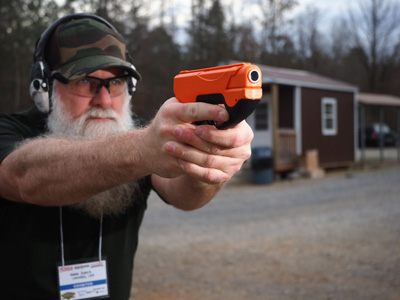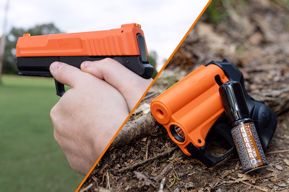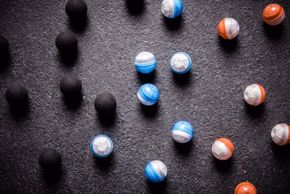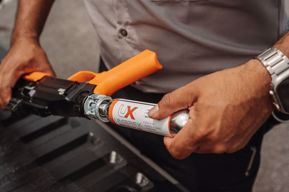 By now, it’s clear that modern lesslethal devices offer improvements over the old keychain pepper spray. But you might be asking: Which should I choose for my needs? To help with that, let’s break down why you should consider a pepper ball pistol over traditional pepper spray, and where pepper gel fits in as well. Below are some key comparisons:
By now, it’s clear that modern lesslethal devices offer improvements over the old keychain pepper spray. But you might be asking: Which should I choose for my needs? To help with that, let’s break down why you should consider a pepper ball pistol over traditional pepper spray, and where pepper gel fits in as well. Below are some key comparisons:
-
Effective Range: Perhaps the biggest advantage of pepper ball launchers is distance. Some pepper ball guns can reach attackers 50, 60, even 150 feet away, far beyond the 5–10 foot range of a handheld spray. Even if your pepper ball pistol’s practical range is, say, 30 feet, that’s still triple or more the range of a spray – meaning you can stop a threat well before they’re on top of you. Pepper gel pistols also extend range to around 15 feet, which is roughly double that of an aerosol can. In short, if you value keeping distance for your safety, pepper balls (and to a lesser extent pepper gel) clearly outshine traditional spray.
-
Stopping Power and Effectiveness: Pepper ball projectiles hit with force and create a cloud of irritant on impact, so you don’t need a perfect shot to incapacitate the assailant. The combination of impact plus pepper cloud tends to change an attacker’s behavior instantly, according to experts. By contrast, pepper spray requires getting that mist squarely in the attacker’s face. If they turn their head or have partial protection (hoodie, glasses), the spray might not fully take them down. Also, a pepper ball can affect multiple attackers if they’re close together – the cloud could disperse to catch two or three people in one shot. A small spray can really only target one person at a time. Pepper gel is somewhere in between: it’s targeted (one person per burst), but it delivers a concentrated dose that sticks, likely incapacitating that individual more reliably than a quick hit of spray would.
-
Multiple Shots and Capacity: In a high stress incident, you might miss or you might face more than one assailant. Traditional pepper spray gives you limited continuous spray – once you start spraying, you might only have a few seconds worth of fluid. Pepper ball pistols usually come with 46 rounds (or more in larger launchers), each a discrete shot. This allows for engaging multiple targets or having retries if the first round doesn’t hit. Pepper gel pistols like the PGS II provide multiple bursts (up to 13) in one cartridge, which is a huge advantage. Essentially, the pepper gel device is designed for multiple engagements – you’re not out of the fight after one spray. This is a critical factor for, say, a woman who might face two attackers or needs to fire a warning burst and then a direct burst. More capacity = more confidence.
-
Safety to User (Reduced Blowback): Pepper ball and pepper gel systems are much safer for the defender to use in terms of not contaminating yourself. Pepper spray blowback is a real concern – one strong gust of wind or a confined space, and you’ll be coughing and crying along with the bad guy. Pepper balls release irritants at the target (far from you), and pepper gel streams hit the target without spreading around you. This minimal cross contamination is a major selling point, especially if you worry about using pepper spray around your kids or in your apartment. For home defense, pepper balls might still fill a room with some irritant (so you’d ventilate after), but pepper gel will not fill the room at all – it stays on the intruder.
-
Visibility and Deterrence: A pepper ball pistol looks like a gun (often with a bright safety color marking) and can intimidate a threat at a glance. The mere act of you pointing it and yelling “stop!” might deter an attacker who doesn’t want to get shot (even if it’s not a firearm, they might not know or want to risk it). Additionally, the noise and physical impact of a pepper ball can cause someone to flee even if they haven’t felt the pepper yet. Pepper spray canisters, on the other hand, are often small and may not be recognized by an attacker until after you’ve sprayed them. There’s less psychological deterrent value; a mugger might think you’re just holding a pen or something until they’re hit with the spray – at which point they may already be striking you. In short, pepper ball guns offer a strong visual deterrent, potentially preventing escalation, whereas a little spray doesn’t “show force” until it’s used.
-
Ease of Aim and Use Under Stress: In a chaotic moment, fine motor skills diminish. Pepper ball guns and pepper gel pistols are aimed like a firearm, which for many people is more intuitive than aiming a tiny spray nozzle. They often have basic sights or a builtin light to help aim. With pepper spray, you have to ensure it’s oriented correctly (many have nozzles you must point the right way) and often you need to put a finger on a small trigger or twist a safety cap. It’s doable, but people have been known to spray themselves by accident in panic or miss entirely if the attacker is moving. The trigger mechanism on pepper ball/gel devices tends to be larger and more gunlike, which can be easier to operate under duress. Also, since many pepper spray guns have automatic safety features (like the grip safety on PGS II), you don’t have to fumble with taking a safety catch off; you just grip and shoot. This could save precious seconds.
-
Indoor vs. Outdoor Use: If your primary concern is home defense, you might lean towards pepper gel or a pepper ball with awareness of ventilation. Pepper gel is explicitly touted as safe for indoor use, because it won’t affect others in the room beyond the target. If you have family members, pets, or are in an apartment building, this controlled effect is reassuring. Pepper ball guns can certainly be used indoors (police do it when needed), but remember that the pepper dust will spread in the area – you’ll want to clear the house for a bit and air it out afterward. That said, pepper balls excel outdoors or in larger spaces (yard, parking lot, campus) where you want range. Regular pepper spray is risky indoors (you’ll fill your own room with pepper) and not great in wind, so it’s mostly suited for fairly calm outdoor conditions or very brief indoor use with immediate escape.
-
Maintenance and Shelf Life: Pepper sprays (aerosol cans) can sometimes lose pressure or potency over time (most have a shelf life of 24 years and need replacement). There’s also the worry of them leaking or the propellant degrading. Pepper ball projectiles often have a shelf life (~2 years is common for maximum potency), and CO₂ cartridges can be stored indefinitely until pierced. Pepper gel cartridges will have expiration dates too (often a few years). The nice thing about pepper ball/gel devices is you can often get inert practice ammo or cartridges to train with. For instance, inert powder balls or waterbased gel cartridges allow you to fire the device in training without actually pepper spraying yourself, so you can see how far it shoots and how to aim. That’s a big plus: you can practice with your tool. Hardly anyone practices with their live pepper spray can (because you don’t want to waste it or suffer exposure). But practicing with a pepper ball gun or pepper gel gun is feasible and recommended – and the more you practice, the more confident and effective you’ll be if the time comes.
Overall, a pepper ball pistol provides a superior defensive reach and often a more formidable presence, which is why you might consider it over a basic pepper spray. A pepper gel pistol, meanwhile, provides a safer and more controlled way to deploy OC pepper than a traditional spray. For someone who doesn’t want a firearm yet wants something more robust than a tiny canister, these P2P devices hit the sweet spot. You’re essentially getting firearmlike capabilities (aiming, trigger control, intimidation factor) without the lethal risk.



